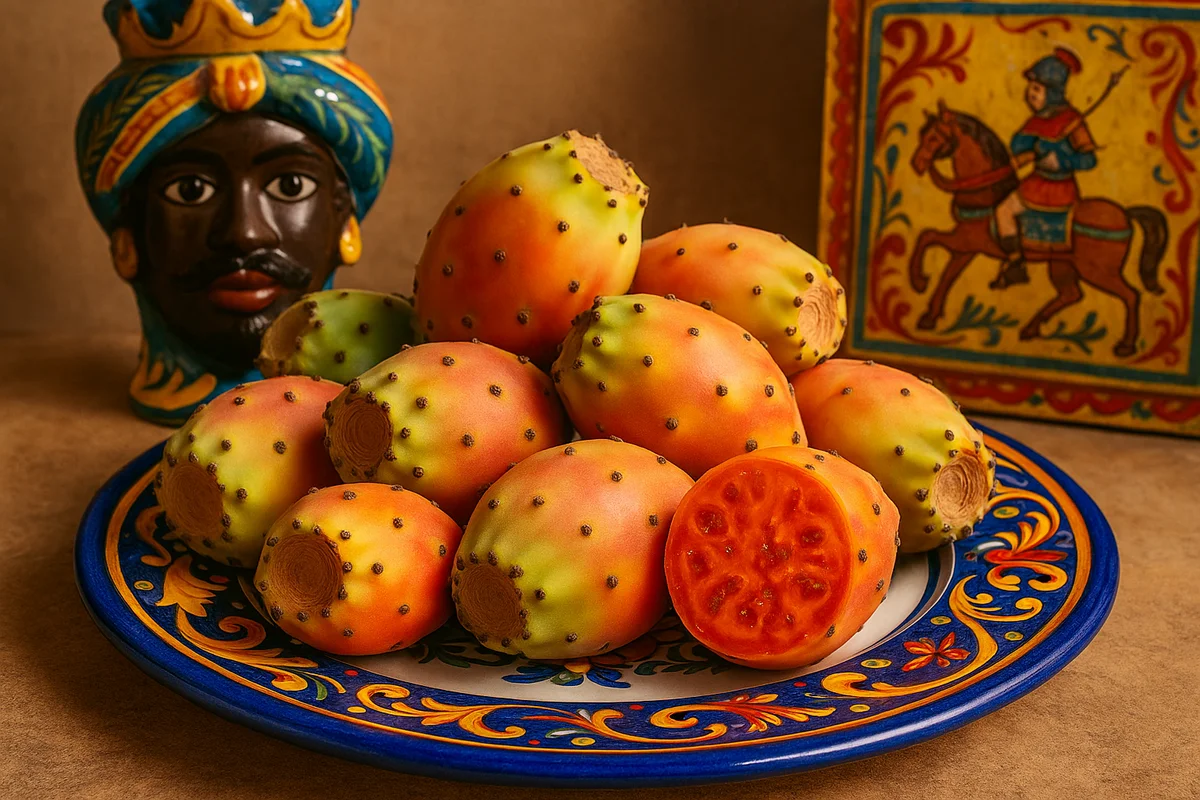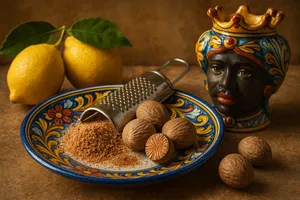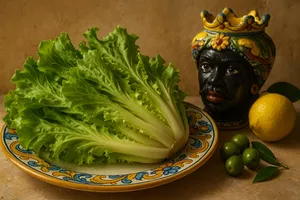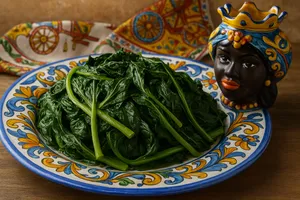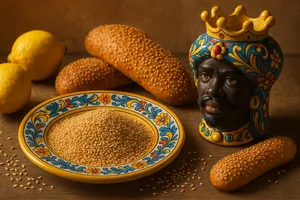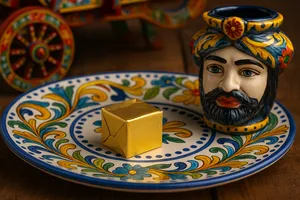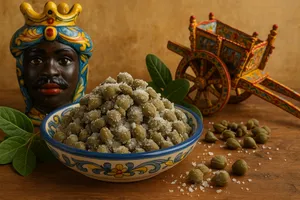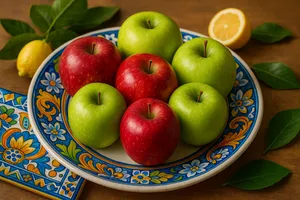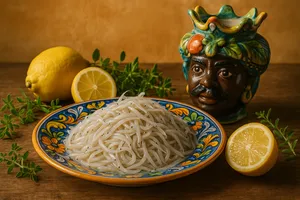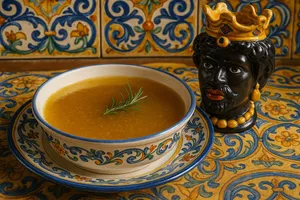Overview
Prickly pears, known in Sicilian as “ficurinia” or “bastarduna”, are the fruits of Opuntia ficus-indica, a cactus native to Mexico that arrived in Sicily after the discovery of the Americas and became perfectly naturalised in the island’s landscape. These distinctive fruits, covered in tiny hair-like spines (glochids), contain a sweet, juicy, refreshing pulp that embodies the flavours of the Sicilian summer and early autumn.
In Sicilian rural culture, prickly pears are deeply tied to the land: the plants grow spontaneously along dry-stone walls, field edges and rocky slopes where few other plants can survive. Harvesting requires skill and specialised tools to avoid the dreaded spines. Eaten fresh as a thirst-quenching fruit on hot days, prickly pears are as symbolic of Sicily as lemons and oranges—proof of the island’s ability to embrace and transform ingredients from distant lands.
Characteristics
Prickly pears are oval to elongated, 5–10 cm long. Their thick skin is dotted with areoles from which glochids emerge—tiny spines that easily detach and penetrate the skin, making handling tricky. Colours range from green to yellow-orange to deep red-purple depending on variety and ripeness.
The inner pulp is juicy, sweet and fragrant, ranging in colour from pale greenish-white to orange-yellow to bright red, studded with many hard but edible seeds. The texture is gelatinous and refreshing; the flavour sweet with mild acidity depending on variety. The aroma is delicate and characteristic.
A perfectly ripe prickly pear yields slightly to pressure, has uniform colour and a pleasantly sweet scent. The blossom end should be slightly softened.
Varieties
Sulfarina (yellow)
Yellow-orange pulp, sweet and aromatic. The most widespread Sicilian variety. Many small seeds.
Sanguigna (red)
Deep red pulp, very sweet and fragrant. Considered the finest for flavour and colour. Fewer seeds than the yellow type.
Muscaredda (white)
Pale greenish-white pulp, delicate and sweet. Less common but highly appreciated.
Bastardoni (late-season fruits)
Fruits from the second flowering, obtained by removing the first crop. Larger, sweeter, fewer seeds, ripen in autumn. The most prized and expensive.
Seasonality
First-season prickly pears ripen from August to September in Sicily. “Bastardoni”, produced through the technique of removing early fruits and flowers (“scuzzulatura”), ripen from October to December.
These autumn fruits are larger, sweeter and have fewer seeds. Production is concentrated in renowned areas such as San Cono, Belpasso and the slopes of Mount Etna.
Harvesting
Harvesting prickly pears requires specific tools to avoid glochids. Traditionally a long cane with a cloth-wrapped fork at the end is used to twist the fruit gently off the pad. Workers (“ficuriniara”) wear thick gloves and follow techniques passed down for generations. Harvest happens early in the morning when temperatures are cooler.
Fruits are then “de-spined” by rubbing with straw or stiff brushes, or by rinsing under running water.
Culinary uses
Fresh consumption
The traditional method is to peel the fruit with knife and fork: remove both ends, make a lengthwise slit and open the skin to extract the pulp. Served chilled, it is a refreshing snack. In Sicily, prickly pears are often eaten at breakfast.
Jam
The pulp is cooked with sugar and lemon to create a fragrant jam. Red varieties yield a striking ruby-coloured preserve.
Jelly
Filtered juice produces a clear, bright jelly used for desserts or as a spread.
Mostarda
A traditional Sicilian dessert where prickly pear juice is cooked down with grape must, starch and spices until thick and creamy, then served cold.
Sorbet and gelato
Blended pulp becomes intensely coloured, refreshing sorbets and ice creams—summer favourites across Sicily.
Syrups and liqueurs
The juice is used to make aromatic syrups and distinctive liqueurs.
Preparation
Even after de-spining, prickly pears should be handled with cutlery or gloves. Trim both ends, make a longitudinal cut in the skin, open it and lift out the pulp without touching the exterior.
Soaking the fruits in cold water for a few hours softens any remaining glochids. For jam or juice, the pulp can be sieved to remove seeds. To extract juice, blend the pulp and strain through a fine sieve or cheesecloth.
Storage
Whole prickly pears keep 3–4 days at room temperature or up to a week in the fridge. Handle gently to avoid bruising.
Peeled pulp keeps 1–2 days in the fridge. Blended pulp freezes well for 6–8 months for later use in sorbets or desserts.
Jam, jelly and mostarda keep up to a year in sterilised jars. Syrups keep several weeks refrigerated.
Buying tips
Choose fruits with intact skin, no bruises or soft spots, and vivid, uniform colour. Avoid very hard (unripe) or overly soft (overripe) fruits.
Ensure the fruits have been de-spined, though caution is always advisable. They should smell sweet and pleasant. Prefer local, in-season produce.
Autumn “bastardoni” are larger and pricier but of superior quality. Red fruits are ideal for jams.
Nutritional properties
Prickly pears provide about 50–55 kcal per 100 g, made up of roughly 83% water and 13% carbohydrates. Protein and fat contents are low.
They are rich in soluble and insoluble fibre, beneficial for digestion (though excessive consumption may cause constipation due to the seeds). They offer vitamin C, vitamin A, B vitamins (especially folate) and minerals such as potassium, magnesium, calcium and phosphorus.
Red varieties contain betalain pigments with antioxidant and anti-inflammatory properties. Traditionally they were considered refreshing, diuretic and beneficial for kidney and bladder health.
Pads (cladodes)
The young pads of Opuntia are edible. Although not widely eaten in Sicily, in some areas tender spring pads are harvested, de-spined and cooked like vegetables—boiled and dressed with olive oil and lemon or added to salads.
Pads are rich in fibre and mucilage and were used in folk medicine as soothing poultices for wounds and inflammation.
Curiosities
Opuntia ficus-indica likely arrived in Sicily in the 16th century. It adapted so well that many consider it native.
The plants were often used to mark property boundaries, forming natural impenetrable barriers thanks to their spines.
A Sicilian saying goes: “U ficurinia nasci puru ‘nta petra” (“The prickly pear grows even from stone”), referring to the plant’s remarkable resilience.
The “scuzzulatura” technique for producing the prized autumn crop was perfected in Sicily and requires great expertise.
San Cono, in the province of Catania, hosts an annual October festival dedicated to prickly pears, celebrating local traditions and products. It is considered the prickly pear capital of Sicily.
Offering prickly pears to guests was a gesture of hospitality. The delicate peeling process often became a shared moment, strengthening social bonds.

